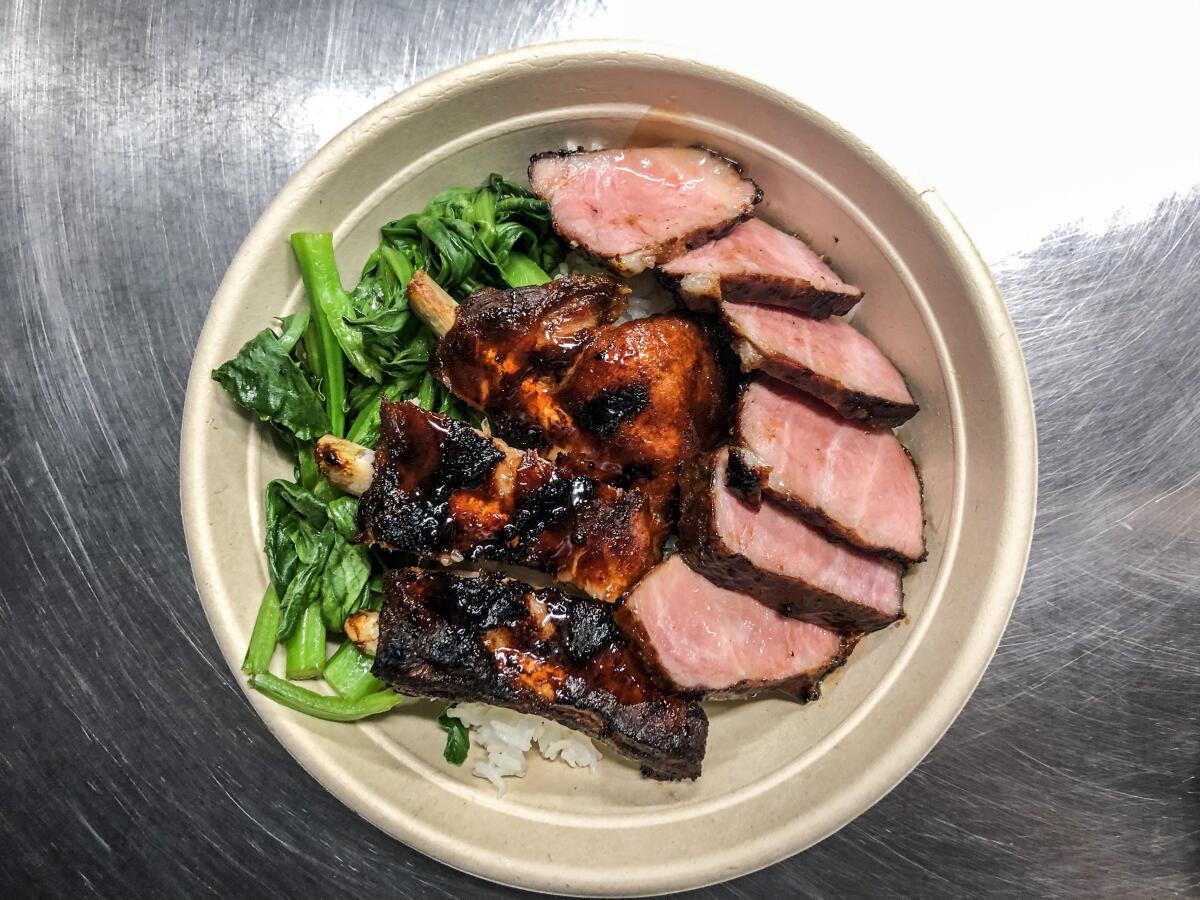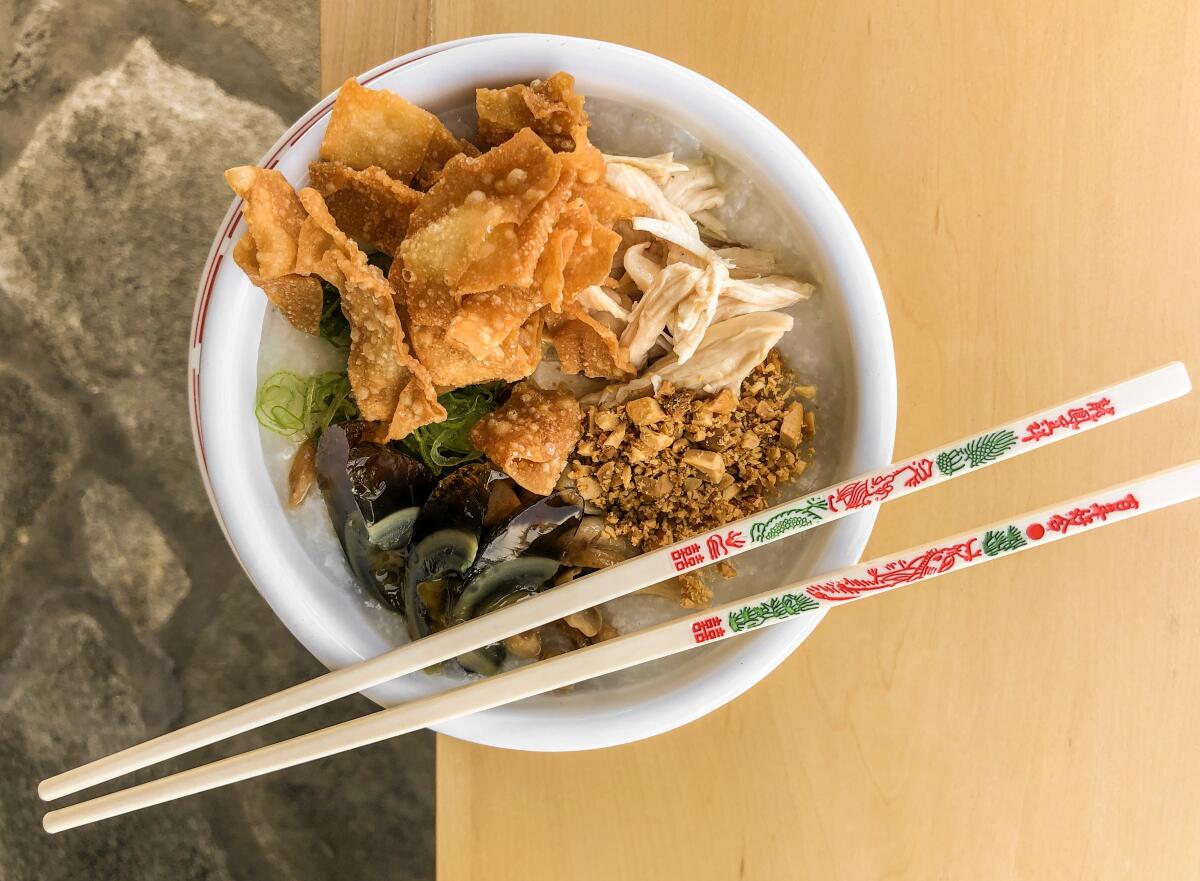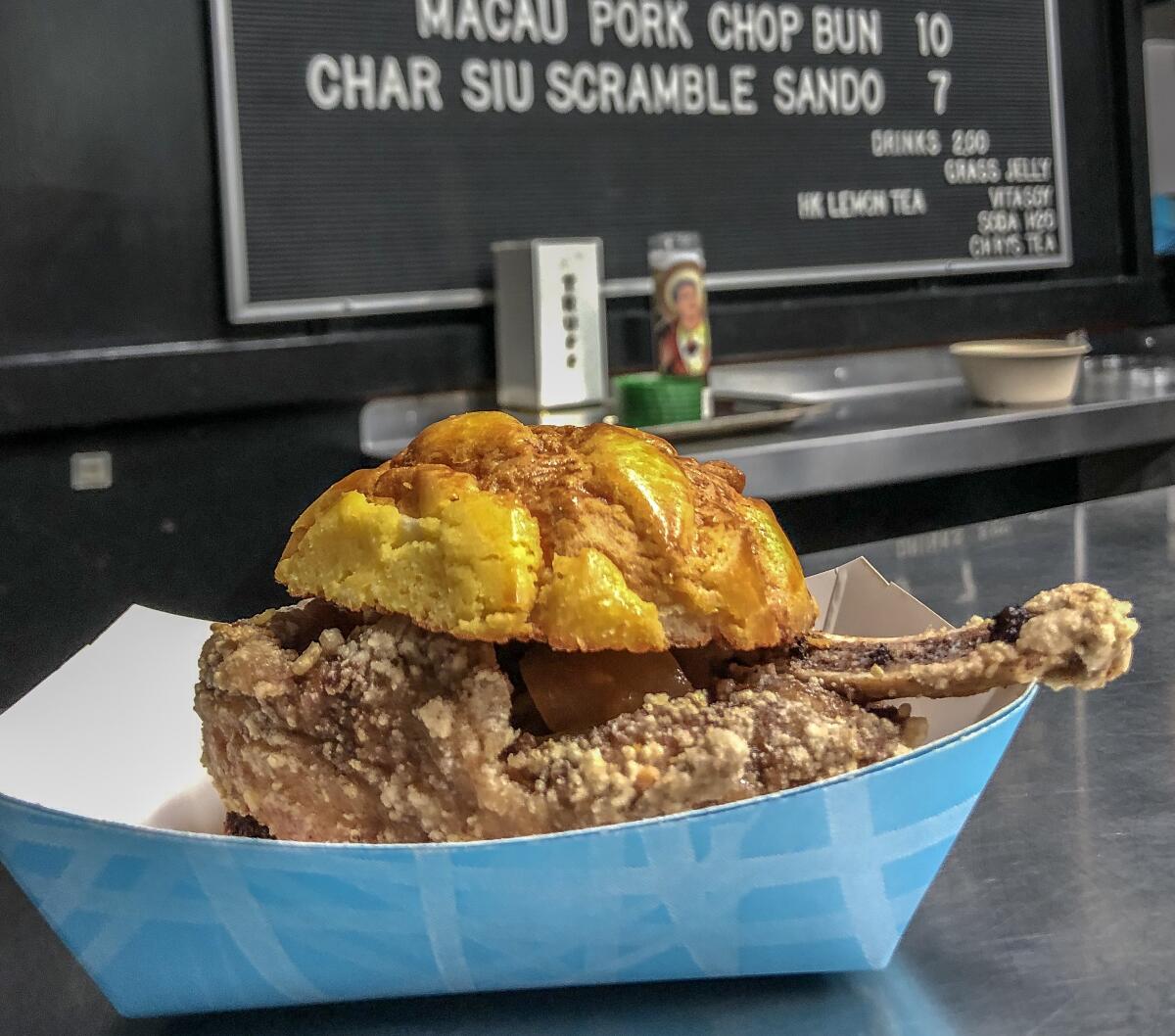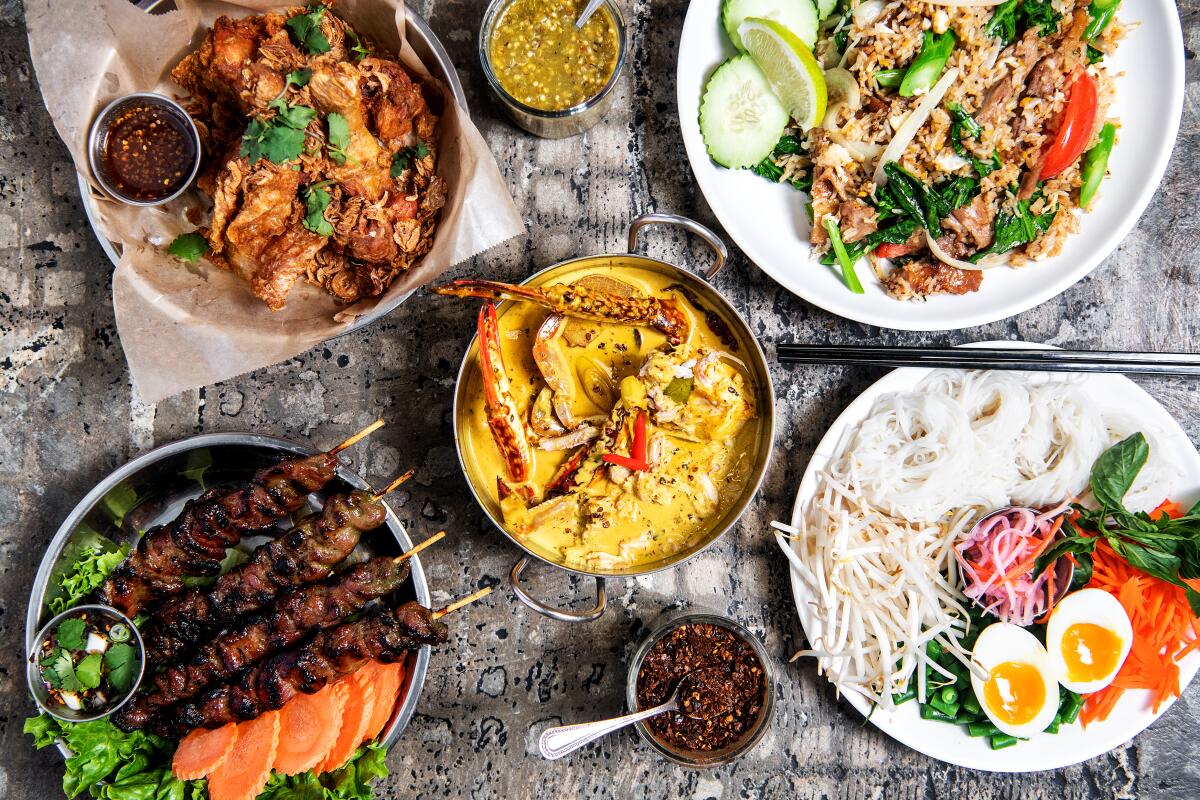Cantonese cuisine’s evolutionary leap in Los Angeles

Last May my colleague Lucas Kwan Peterson wrote a column about a string of 1980s-era Cantonese restaurants that had recently closed in the San Gabriel Valley. The closures included three Monterey Park behemoths — Ocean Star Restaurant, Empress Harbor Seafood Restaurant and Lincoln Seafood — that relied on opulent banquets and the popularity of weekend dim sum cart service to thrive.
Eat your way across L.A.
Get our weekly Tasting Notes newsletter for reviews, news and more.
You may occasionally receive promotional content from the Los Angeles Times.
Lucas discussed a combination of reasons for their shuttering: the ever-increasing costs of running large restaurants; business models that likely relied on grueling work conditions; and, from a cultural standpoint, changing generational tastes.
The shift in palates and predilections makes sense considering the breadth of regional Chinese options in the SGV. The area’s early waves of immigrants arrived from the coastal Guangdong province (formerly known as Canton); immigration from Mainland China over the last couple of decades has given us da pan ji (“big plate chicken”) and hand-pulled noodles from Xinjiang province, Beijing-style lamb pie, salted Nanjing duck, Shanghainese yan du xian (double pork soup with bamboo shoots), the many nuanced glories of modern Sichuan cooking ... and so much more.
Cantonese restaurants, saddled with an unfairly fusty reputation, can drift into the background in the churn of all these exhilarating new regional specialists.
The term “Cantonese” encompasses Guangdong’s direct, lightly seasoned, vegetable-rich cooking and also the mingled, urban foodways of nearby Hong Kong and Macao, with their centuries of global influences.
I treasure the SGV’s culinary pluralism; I would also mourn the loss of ambitious Cantonese cooking in our area. So it’s been encouraging to see three new Cantonese-influenced restaurants open in recent months outside the SGV. Each of them tells a story about directions in the cuisine’s local evolution.
Chef Tony opened in Pasadena last month. It’s the latest restaurant from Tony He, who owns 17-year-old Seafood Harbour in Rosemead. He runs two similar restaurants in Richmond, British Columbia. Seafood Harbour leans to oceanic luxuries; Chef Tony takes a more casual, lighthearted and often Westernized approach to the cuisine, particularly dim sum. (He doesn’t shy from the word “fusion.”) Har gaw comes in dumpling wrappers dyed opaque with squid ink and topped with gold leaf; pork and shrimp siu mai are adorned with black truffles.
More compelling to me is the use of regional seafood in more traditional dishes, such as Dungeness crab or local prawns stir-fried in black pepper. For his Richmond restaurants He has squab and water fowl raised locally to his specifications (smaller, without antibiotics) for dishes he char-grills, and though they’re not yet on the Pasadena menu I hope they’ll appear as specials.
The other restaurants, both in Los Angeles proper, come from two young chefs cooking to maintain connection with their heritage.

Ryan Wong, who grew up in the SGV, worked at Trois Mec and Otium over the last decade before opening Needle in Silver Lake four months ago. “I never really connected with the food I was cooking in fine dining,” Wong said in a telephone interview. “It was great to learn the techniques, but I didn’t feel it deep down. I wanted to figure out my own voice, referring back to food memories of my mom and my family in the kitchen.”
Wong’s restaurant is purposefully low-key: Nothing costs more than $14, and orders are taken at the counter. Among the cold dishes are wood-ear and frilly snow fungus mushrooms fragrant with ginger, scallion and chile oil and cucumbers paired with the faint funk of black garlic. White cut chicken with dipping sauces is an antecedent of Singapore’s famous Hainanese chicken. The cooks make char siu in small batches throughout the day so the pork tastes ultra-fresh. At brunch Wong serves the deep-fried, peanut-butter-stuffed sandwich known as “Hong Kong French toast”; the dish is emblematic of that city’s tea cafe culture.
Wong is thinking through ways that California bounty innately melds with Cantonese technique. He stir-fries pea shoots in garlic, a standard in the repertoire, but then adds an herbal vegetable stock of local winter vegetables infused with goji berry and jujubes (which I saw fresh right down the street from Needle at Saturday’s Silver Lake farmers market).
On the more caloric side, there’s a variation of pork chop bun, a classic snack made here with fried pork loin cutlet on a domed homemade milk bread bun with a vegetable relish and pickled cucumber.
Compare it to the one chef Johnny Lee is making at his brand-new Pearl River Deli in Chinatown’s Far East Plaza. Lee makes a pineapple bao, a sugared bun so named because its crunchy, cross-hatched crown resembles the fruit. He plops a whole, bone-in pork chop on the split bao and slicks on mayo and sofrito. It’s pretty irresistible. Lee was inspired by versions he’s seen in Macau (and watched Anthony Bourdain savor on television).

It’s a staple on the Pearl River Deli’s short, mercurial menu. Lee took over the space recently vacated by Eddie Huang’s Baohaus, which sits next to Howlin’ Ray’s and its forever-trailing lines. Lee is best known for his obsessive take on Hainanese chicken, which he served for a couple of years at Side Chick in the Westfield Santa Anita. His family roots stem from Taishan, Guangdong; many of California’s earliest, 19th century Chinese immigrants arrived from the area.
“I’ve come back to food that I want to eat,” Lee said over the phone. He, too, is making char siu, sticky and charred and served over rice. He makes a comforting classic of silky eggs with shrimp (Needle frequently does as well). In the summer, to take advantage of the local produce, he’ll make Cantonese stir-fried eggs with meaty heirloom tomatoes. A sweet and sour dish is in the works, to help restore the good name of that long-standing Cantonese dish, often made tart with hawthorn berry.
No cuisine stays vital if it isn’t considered with fresh eyes, with eager hands, with curious minds willing to understand history in order to create the future. It’s awesome to see some fresh, sudden energy around Cantonese cooking. Look for formal reviews of all three restaurants in the coming months.
Enjoying this newsletter? Consider subscribing to the Los Angeles Times
Your support helps us deliver the news that matters most. Become a subscriber.
Ask the Critics
I’d love to go eat delicious food and support the Chinese-American community. As a vegetarian (no fish either), I often think that I can’t really get “authentic” food (vs. Americanized). Any suggestions?
— Amy S., via email
This seemed like an on-theme question to answer this week. Of course, the notion of what is “authentic” and what is “Americanized” is one of the great brambly topics of dining culture (and food writing), but I know what you’re saying, and yeah, this isn’t an easy one. I wholly support vegetarianism in restaurants, but I’m not a fan of rambling, catch-all menus over-eager to please too many people. Two thoughts, then:
Half the menu at Needle is vegetarian, or can easily be, so I’d say start there. Ryan Wong’s Taishan cauliflower riffs on cashew chicken but is meat-free; a finishing spritz of pomelo gives the dish a seasonal, citrusy edge.
Happy Family is a long-standing vegan restaurant in Monterey Park; it hews to the Buddhist-style cooking of meat substitutions. Wheat gluten puffs aren’t my favorite. I stand by Happy Family’s homey casserole dishes, including eggplant and tofu in black pepper sauce and curried pumpkin with other vegetables and tofu.
Anyone have other suggestions for regionally specific vegetarian Chinese cooking? Email me at bill.addison@latimes.com.
Have a question for the critics?
Top stories

—If the above discussions make you hungry but you’re more in the mood to cook at home, Genevieve Ko has a recipe for yang chow fried rice inspired by classic SGV restaurants.
— Patricia Escárcega reviews Bar Avalon in Echo Park; it’s from a coffee company, Revelator, I remember from my Atlanta days, though Patricia says this restaurant’s draws lean more to wine, thanks to sommelier and general manager Nathaniel Muñoz.
— Speaking of wine: Garrett Snyder reports on the natural wine selections slipping into the menu options at Philippe’s. (Yes, the French dip institution.)
— I write about a restaurant that quite grew on me over the last year: Hollywood’s Luv2eat Thai Bistro.
— On this week’s episode of the Bucket List, Jenn Harris joins actor Valerie Bertinelli and writer Jo Stougaard for a wing crawl. Don’t sleep on the lemongrass and black pepper wings at E.P. & L.P.
— Erick Galindo takes a look at the ways small, entrepreneurial food vendors are using social media to reach a client base (often directly, as in direct messages).
— Ben Mims brought an amazing honey cake into the office the other week. After we all swooned, he revealed the secret: box mix. It’s from a wonderful new book, “Eat Something,” by authors Evan Bloom and Rachel Levin and artist George McCalman.
Eat your way across L.A.
Get our weekly Tasting Notes newsletter for reviews, news and more.
You may occasionally receive promotional content from the Los Angeles Times.



